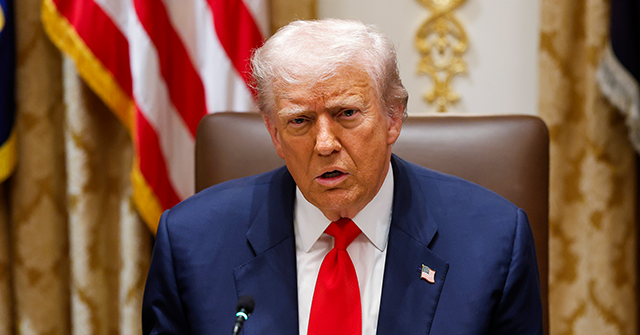Another Federal Reserve Tarifflation Study Falls Apart Under Scrutiny
The St. Louis Federal Reserve released a study last week claiming that President Trump’s 2025 tariffs have added roughly 0.5 percentage points to consumer inflation. The analysis, published on the bank’s “On the Economy” blog, uses sophisticated econometric modeling to trace how tariff costs flow through to consumer prices.
There’s just one problem: the study does not actually show that tariffs are adding to inflation. In fact, the data the study depends on can be just as easily deployed to show that tariffs are decreasing inflation by holding down prices on non-tariffed items.
The Fed researchers ran a statistical comparison of how prices moved across categories with different tariff exposure, a form of what economists like to call a regression. They measured how much prices rose across various categories and compared that to each category’s exposure to tariffs. Categories hit hardest by tariffs—furniture, electronics, pharmaceuticals—saw bigger price increases than categories with little tariff exposure.
From this, they concluded tariffs caused inflation. But the data doesn’t show that. All it actually shows is that tariffed goods rose relative to non-tariffed goods.
The researchers assume this relative price change means tariffed goods deviated upward from what prices “should have been.” But the exact same data is equally consistent with the opposite interpretation: non-tariffed goods deviated downward. It is also consistent with the idea that tariffs may have pushed up prices of some goods while pushing down the prices of others.
The Fiscal Channel They Ignored
There’s a good reason to think non-tariffed goods are actually the ones deviating. Tariffs don’t just raise import costs. They also raise government revenue and reduce the deficit.
Standard macroeconomic theory—the kind the Congressional Budget Office uses—says deficit reduction is disinflationary in the near term. It dampens aggregate demand. When demand falls, prices fall. Which categories should be most sensitive to domestic demand conditions? Services. Non-tradables. Goods with high domestic content. In other words: the low-tariff-exposure categories.
So, the fiscal channel predicts exactly what would produce the Fed’s regression result: non-tariffed prices fall below trend due to fiscal drag, while tariffed prices face two offsetting forces (higher costs versus lower demand) and end up closer to trend.
The researchers didn’t control for fiscal impulse or deficit reduction. They didn’t account for the demand-side effects of tariff revenue. They just ignored half of what economists call the general equilibrium.
The “Short Horizon” Excuse Doesn’t Work
In the Federal Reserve note the St. Louis Fed study cites, there’s a defense of this approach: over short time horizons, we can safely ignore downward pressure on non-tariffed goods.
But why is downward pressure “safely” ignored? If six to eight months is enough time for tariff pass-through to raise prices, it’s enough time for fiscal and demand shifts to lower them. Here it looks like the researchers decided to assume asymmetric price dynamics that conveniently validate their preferred interpretation.
It’s true that economists sometimes like to say that prices rise like a rocket but fall like a feather. But that’s based on an outdated view of how retail prices work. In the modern market for merchandise and services, prices respond quite quickly to demand in both directions.
Consider that many of the retailers selling tariffed goods also sell non-tariffed goods. Walmart, Amazon, Target—they’re not adjusting prices in isolated category-by-category silos. They’re managing portfolio pricing across thousands of products simultaneously. If Best Buy faces higher costs on electronics but weaker foot traffic due to fiscal drag, they might raise prices on constrained imports while cutting prices on other items to drive customers through the door. These adjustments happen in the same planning meetings, on the same timeline.
The idea that tariffed goods respond in months one through eight while non-tariffed goods somehow don’t adjust yet is empirically absurd when they’re literally on the same shelf, managed by the same pricing algorithms, and sold by the same firms. Strategic pricing means if the Fed’s regression finds “tariffs added 5 percentage points to the differential,” the net effect on your total shopping cart could still be zero.
To put it slightly differently, the Fed researchers are engaging in single-entry inflation accounting. They measure inflation by multiplying category-level price changes by spending weights. This gives them a “gross contribution” from tariff-exposed items. But it doesn’t subtract any offsetting disinflation in low-exposure categories that could arise when consumers shift spending away from expensive tariffed goods.
They might be measuring a reallocation of inflation across categories, not a net rise in the overall price level. A simple robustness check—comparing a high-tariff-exposure basket to a low-exposure basket with fixed weights—would show whether headline inflation actually rose or just tilted toward certain categories. They didn’t do this.
Fed Researchers Always Find That Tariffs Cause Inflation
This isn’t the first time Federal Reserve researchers have published analysis of Trump administration trade policies that fall short of their claims about tariffs causing inflation. It probably won’t be the last.
But this case is particularly egregious because the methodological problems aren’t subtle. The researchers have one equation and two unknowns. They “solve” it by assuming one unknown equals zero.
To be clear: at least in the short-term, tariffs probably do raise costs on some imported goods, and some of that gets passed to consumers. But whether that translates into higher overall inflation depends on what happens to everything else, and the Fed’s model can’t tell you that.
The Fed’s own data is perfectly consistent with tariffs having reduced inflation, increased inflation, or had no effect at all. Their regression can’t tell you which. But you can be sure that pundits and economists will cite this research as if it told us tariffs were increasing inflation.
Read the full article here


